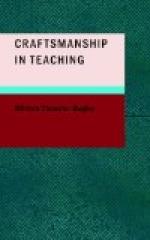You have all heard the story of the great chemist who was at work in his laboratory when word was brought him that his wife was dead. As the first wave of anguish swept over him, he bowed his head upon his hands and wept out his grief; but suddenly he lifted up his head, and held before him his hands wet with tears. “Tears!” he cried; “what are they? I have analyzed them: a little chloride of sodium, some alkaline salts, a little mucin, and some water. That is all.” And he went back to his work.
The story is an old one, and very likely apocryphal, but it is not without its lesson to us in the present connection. Unless we distinguish between these two factors that I have named, we are likely either to take this man’s attitude or something approaching it, or to go to the other extreme, renounce the accuracy and precision of the scientific method, and give ourselves up to the cult of emotionalism.
Now, while we do not wish to read out of the teaching of literature the factors of appreciation and inspiration, we do wish to find out how these important functions of our teaching may be best fulfilled. And it is here that facts and principles gained by the scientific method not only can but must furnish the ultimate solution. We have a problem. That problem, it is true, is concerned with something that is not scientific, and to attempt to make it scientific is to kill the very life that it is our problem to cherish. But in solving that problem, we must take certain steps; we must arrange our materials in certain ways; we must adjust hard and stubborn facts to the attainment of our end. What are these facts? What is their relation to our problem? What laws govern their operation? These are subordinate but very essential parts of our larger problem, and it is through the scientific investigation of these subordinate problems that our larger problem is to be solved.
Let me give you an illustration of what I mean. We may assume that every boy who goes out of the high school should appreciate the meaning and worth of self-sacrifice as this is revealed (not expounded) in Dickens’s delineation of the character of Sidney Carton. There is our problem,—but what a host of subordinate problems at once confront us! Where shall we introduce The Tale of Two Cities? Will it be in the second year, or the third, or the fourth? Will it be best preceded by the course in general history which will give the pupil a time perspective upon the crimson background of the French Revolution against which Dickens projected his master character? Or shall we put The Tale of Two Cities first for the sake of the heightened interest which the art of the novelist may lend to the facts of the historian? Again, how may the story be best presented? What part shall the pupils read in class? What part shall they read at home? What part, if any, shall we read to them? What questions are necessary to insure appreciation?




